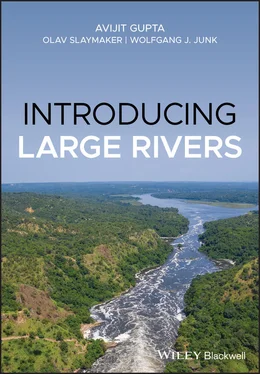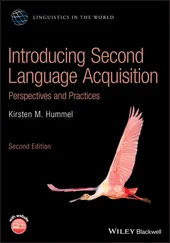A river system may be terminated by other events such as a large -scale marine invasion, a new tectonic deformation, outpouring of lava or continental glaciation (Potter 1978). Tectonic, geomorphic and climatic processes may also modify an earlier drainage. The collision of the Indian and Eurasian Plates resulted in crustal shortening, differential shear and rotation associated with the rise of the Himalaya. An existing river may disappear through river capture, climate change resulting in a drier environment, or deformation due to plate tectonics. The change may affect almost the entire basin or only part of the drainage system. Potter (1978) has described rivers which were an assemblage of parts as having a composite age. Some rivers may persist in spite of major interruptions to experience over a long existence. The major rivers, their deltas, and offshore trenches underwent multiple changes during the Pleistocene. Goodbred Jr (2003) has traced the series of modifications that the Ganga River underwent since Marine Isotope Stage 3 (MIS 3, 58 000 years ago), mainly due to climate change.
The origin of a large river requires a suitable geological framework that creates (i) a large basin and (ii) a major river that slopes from elevated headwaters to the edge of the continent. Such developments happen primarily via plate tectonics although there could be other explanations. Sufficient precipitation needs to be accumulated in the basin to support and maintain the river. The basic form and function of the river that flows on the surface are spatially modified further by regional and local tectonics.
The size of the basin and the river is determined by plate tectonics and the amount of precipitation received by the area. The size of the river may change because of (i) plate movements which may lead to crustal spread or shortening and (ii) increase or decrease of precipitation. A large river therefore has a beginning and an end, and exists for a length of time. Several rivers such as the Mississippi or the Nile are very old and include parts of an earlier system. Many large rivers of the present are much younger, a number of them coming into existence or being drastically modified after the formation of the young fold mountains such as the Andes or the Himalaya.
1 What are the characteristics of large rivers? Do all large rivers have the same characteristics?
2 What kind of geological framework is required for a large river to exist? How do such frameworks originate?
3 How old are large rivers?
4 Mertes and Dunne (2007) described the relationship between structure and morphology of the Lower Amazon River. Describe such a relationship for a large river of your choice.
5 Discuss the sedimentary fill below a large river. Does it rest on a smooth rock surface? Give examples in support of your discussion.
6 Do large rivers stay the same in appearance and behaviour over time?
1 Brookfield, M.E. (1998). The evolution of the great river systems of southern Asia, during the Cenozoic India-Asia collision: rivers draining southwards. Geomorphology 22: 285–312.
2 Burbank, D.H. (1992). Causes of recent Himalayan uplift deduced from depositional pattern in the Ganga basin. Nature 357: 680–683.
3 Clift, P.D. and Blusztajn, J.S. (2005). Reorganization of the western Himalayan river system after five million years ago. Nature 438: 1001–1003.
4 Cox, K.G. (1989). The role of mantle plumes in the development of continental drainage patterns. Nature 342: 873–877.
5 Ervin, C.P. and McGinnis, L.D. (1975). Reelfoot rift: reactivated precursor of the Mississippi embayment. Geological Society of America, Bulletin 86: 1287–1295.
6 Fielding, C.R. (2007). Sedimentology and stratigaphy of large river deposits: recognition in the ancient record, and distinction for ‘Incised Valley Fills’. In: Large Rivers: Geomorphology and Management (ed. A. Gupta), 97–113. Wiley.
7 Franzinelli, E. and Igreja, H. (2002). Modern sedimentation in the Lower Negro River, Amazonas State, Brazil. Geomorphology 44: 259–271.
8 Goodbred, S.L. Jr. (2003). Response of the Ganges dispersal system to climate change: a source-to-sink view since the last interstade. Sedimentary Geology 162: 83–104.
9 Gupta, A. (2004). The Mekong River: morphology, evolution and palaeoenvironment. Journal of Geological Society of India 84: 525–533.
10 Gupta, A. (2007). The Mekong River: morphology, evolution, management. In: Large Rivers: Geomorphology and Management (ed. A. Gupta), 435–455. Wiley.
11 Knox, J. (2007). The Mississippi River system. In: Large Rivers: Geomorphology and Management (ed. A. Gupta), 145–182. Wiley.
12 Licht, A. and Giosan, L. (accepted for publication). The Ayeyarwady River. In: Large Rivers: Geomorphology and Management, 2e (ed. A. Gupta). Wiley.
13 Meade, R.H. (2007). Transcontinental moving and storage: the Orinoco and Amazon Rivers transfer the Andes to the Atlantic. In: Large Rivers: Geomorphology and Management (ed. A. Gupta), 45–63. Wiley.
14 Mertes, L.A.K. and Dunne, T. (2007). Effects of tectonism, climate change, and sea-level change on the form and behaviour of the modern Amazon River and its floodplain. In: Large Rivers: Geomorphology and Management (ed. A. Gupta), 115–144. Wiley.
15 Milliman, J.D. and Syvitski, J.P.M. (1992). Geomorphic/tectonic control of sediment discharge to the ocean: the importance of small mountainous rivers. Journal of Geology 100: 525–544.
16 Potter, P.E. (1978). Significance and origin of big rivers. Journal of Geology 86: 13–33.
17 Robinson, R.A., Brezina, C.A., Parrish, R.R. et al. (2014). Large rivers and orogens: The evolution of the Yarling-Tsangpo-Irrawaddy system and the eastern Himalayan syntaxis. Gondwana Research 26 (1): 112–121.
18 Said, R. (1994). Origin and evolution of the Nile. In: The Nile: Sharing a Scarce Resource (eds. P.P. Howell and J.A. Allan), 17–26. Cambridge: Cambridge University Press.
19 Schumm, S.A. (1977). The Fluvial System. New York: Wiley.
20 Shukla, U.K., Singh, I.B., Sharma, M., and Sharma, S. (2001). A model of alluvial megafan sedimentation: Ganga megafan. Sedimentary Geology 144: 243–262.
21 Singh, H., Prakash, B., and Gohain, K. (1993). Facies analysis of the Kosi megafan deposits. Sedimentary Geology 85: 87–113.
22 Tandon, S.K. and Sinha, R. (2007). Geology of large river systems. In: Large Rivers: Geomorphologyn and Management (ed. A. Gupta), 7–28. Wiley.
23 Woodward, J.C., Macklin, M.G., Krom, M.D., and Williams, M.A.J. (2007). The Nile: evolution, Quaternary river environments and material fluxes. In: Large Rivers: Geomorphology and Management (ed. A. Gupta), 261–291. Wiley.
24 Yang, D., Li, X., Ke, X. et al. (2001). A note on the troughs in the Three Gorges Channel of the Changjiang River, China. Geomorphology 41: 137–142.
3 Water and Sediment in Large Rivers
3.1 Introduction
The potential locations of large river basins are determined mainly by plate tectonics. The existence of a large river is possible in such locations provided a high amount of precipitation fell on the basin and is transformed into river discharge. An integrated network of channels is needed to concentrate the basin runoff into a big main channel. A large river basin also includes actively eroding landforms which provide a significant volume of sediment. This chapter introduces the general sources of water and sediment for such rivers.
3.2 Discharge of large Rivers
River discharge ( Q ) is computed as the volume of water passing a given point on the river in unit time. It is measured in m 3s −1, or for annual or long-term periods for large rivers in km 3year −1. Two rivers can be compared by normalising their discharges into runoff ( R ) which is discharge per unit area of the basin ( R = Q / A ). The standard expression of runoff is
Читать дальше












